Abstract
1. The equilibrium constant at 38° and I 0·25 of the triose phosphate isomerase reaction was found to be 22·0 and that of the aldolase reaction, 0·99×10−4m. The [dihydroxyacetone phosphate]/[glyceraldehyde phosphate] ratio was found to be 9·3 in rat liver. The causes of the apparent deviation of the triose phosphate isomerase system from equilibrium in vivo have been investigated. 2. The equilibria of the triose phosphate isomerase and aldolase reactions were studied with relatively large concentrations of crystalline enzymes and small concentrations of substrates, approximating to those found in rat liver and muscle. There was significant binding of fructose diphosphate by aldolase under these conditions. There was no evidence that binding of glyceraldehyde phosphate by either enzyme affected the equilibria. 3. The deviation from equilibrium of the triose phosphate isomerase system in rat liver can be accounted for by the low activity of the enzyme, in relation to the flux, at low physiological concentrations of glyceraldehyde phosphate (about 3μm). It has been calculated that a flux of 1·8μmoles/min./g. wet weight of liver would be expected to cause the measured degree of disequilibrium found in vivo. 4. The conclusion that the triose phosphate isomerase is not at equilibrium is in accordance with the situation postulated by Rose, Kellermeyer, Stjernholm & Wood (1962) on the basis of isotope-distribution data. 5. The triose phosphate isomerase system is closer to equilibrium in resting muscle probably because of a very low flux and a high enzyme concentration. 6. The aldolase system deviated from equilibrium in rat liver by a factor of about 10 and by a much greater factor in resting muscle. 7. The measurement of total dihydroxyacetone phosphate and glyceraldehyde phosphate content indicates the concentrations of the free metabolites in the tissue. This may not hold for fructose diphosphate, a significant proportion of which may be bound to aldolase.
Full text
PDF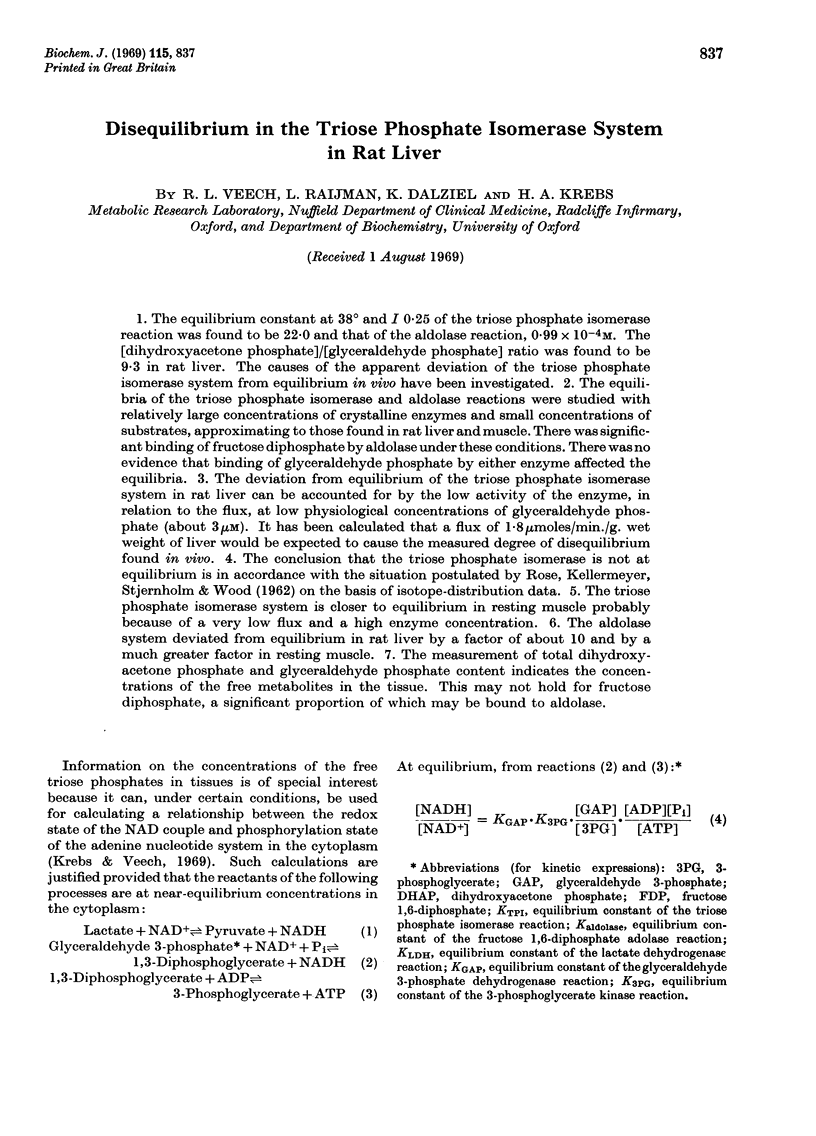
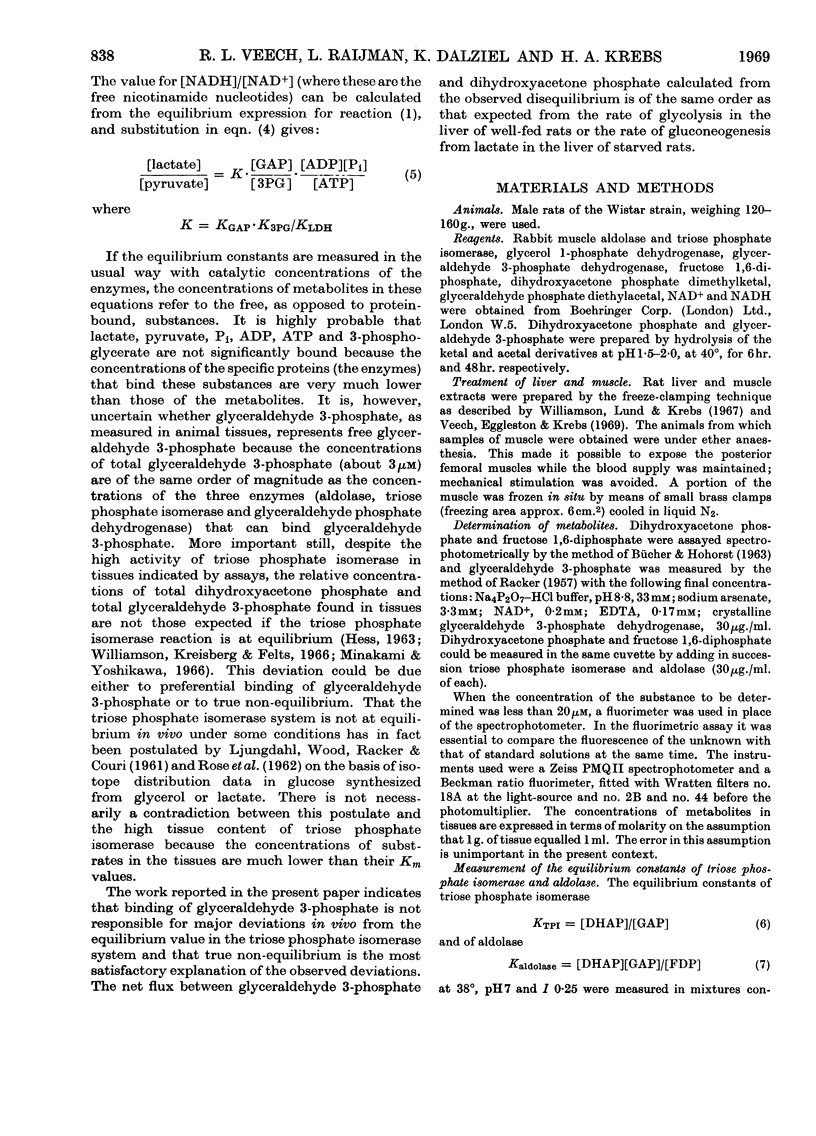
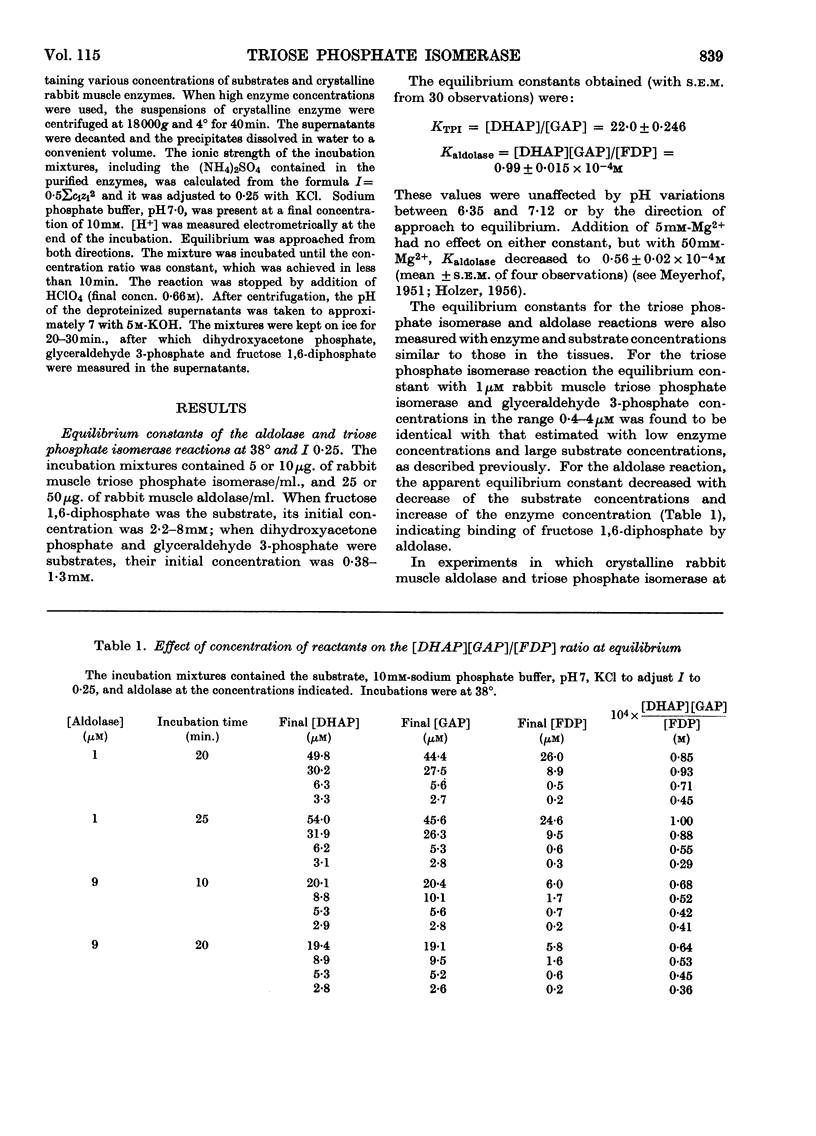
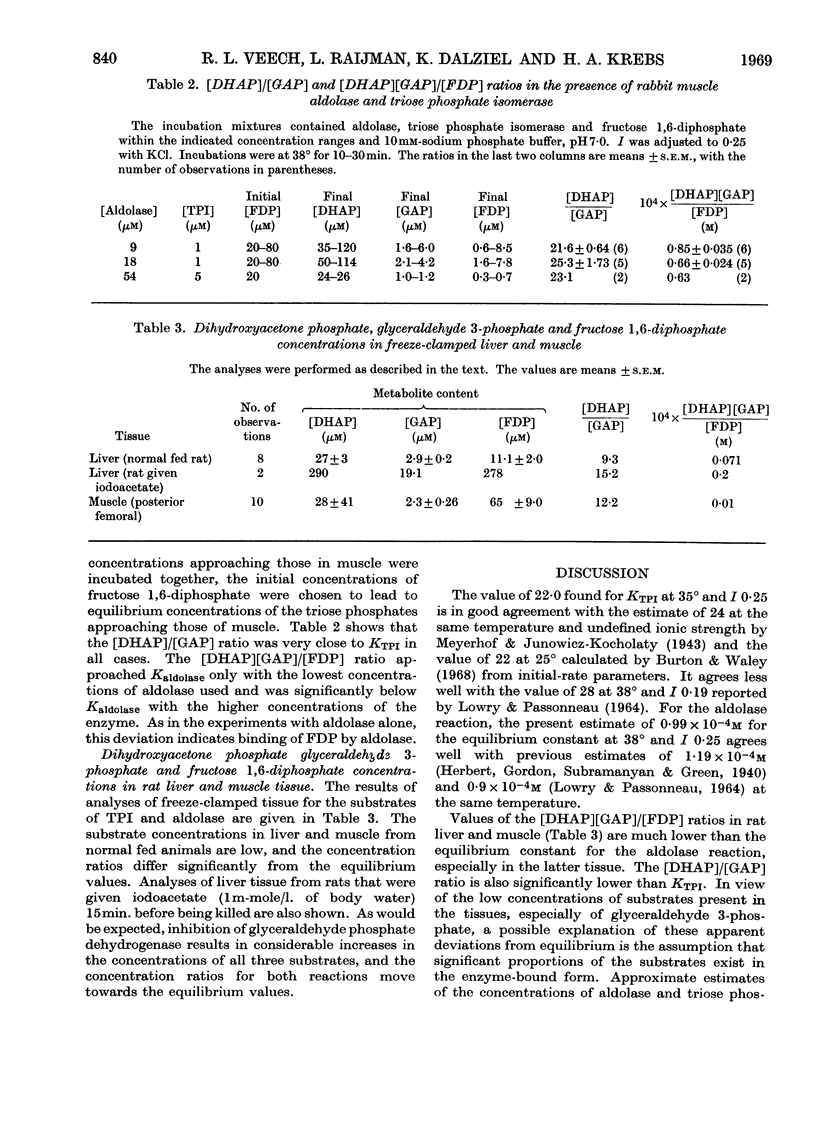
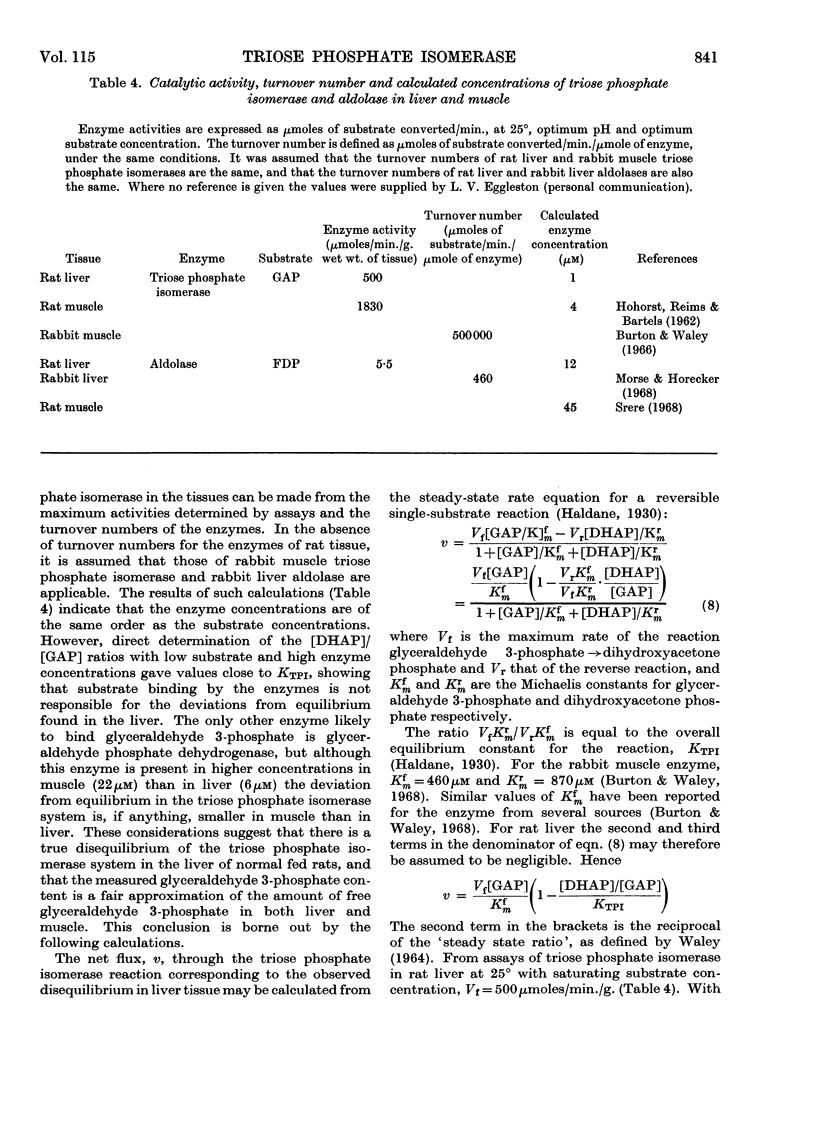
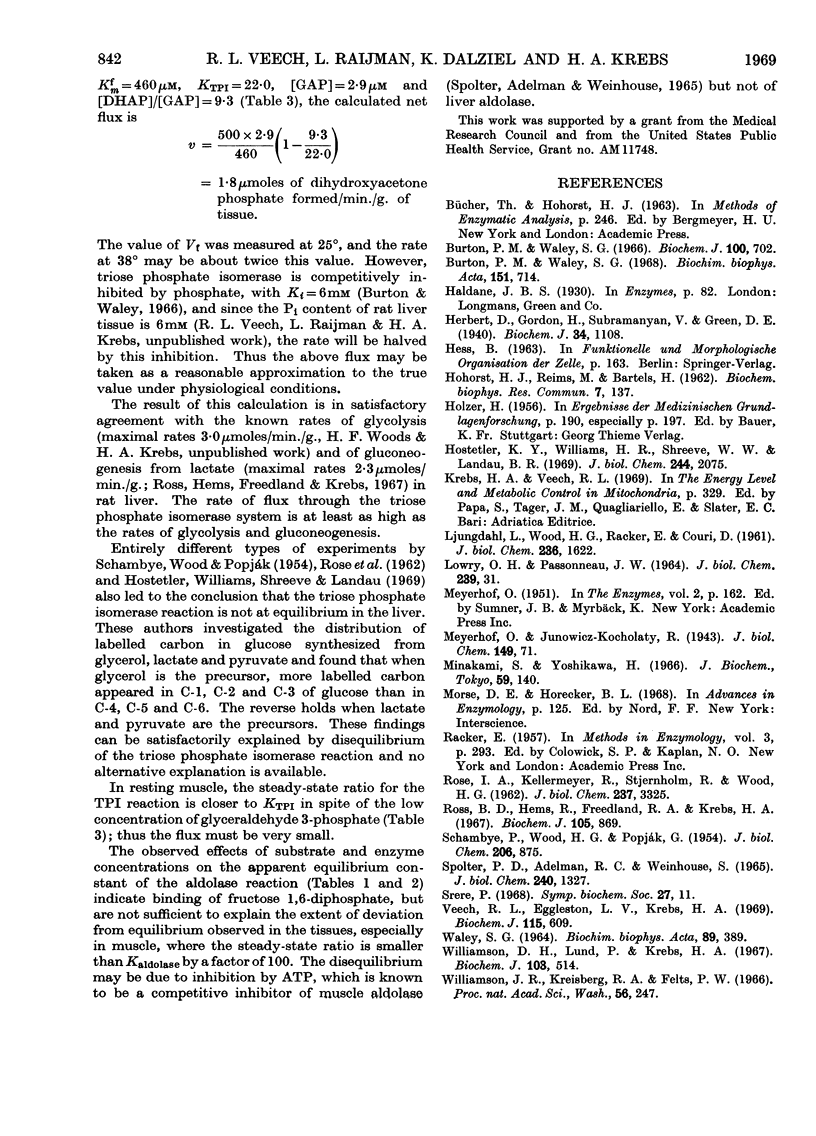
Selected References
These references are in PubMed. This may not be the complete list of references from this article.
- Burton P. M., Waley S. G. Kinetics of triose phosphate isomerase. Biochim Biophys Acta. 1968 Mar 25;151(3):714–715. doi: 10.1016/0005-2744(68)90028-4. [DOI] [PubMed] [Google Scholar]
- Burton P. M., Waley S. G. The active centre of triose phosphate isomerase. Biochem J. 1966 Sep;100(3):702–710. doi: 10.1042/bj1000702. [DOI] [PMC free article] [PubMed] [Google Scholar]
- HOHORST H. J., REIM M., BARTELS H. Equilibria of two-partner reactions of energy supplying metabolism in muscle. Biochem Biophys Res Commun. 1962 Apr 3;7:137–141. doi: 10.1016/0006-291x(62)90162-6. [DOI] [PubMed] [Google Scholar]
- Herbert D., Gordon H., Subrahmanyan V., Green D. E. Zymohexase: With an Addendum by E. C. Bate-Smith. Biochem J. 1940 Jul;34(7):1108–1123. doi: 10.1042/bj0341108. [DOI] [PMC free article] [PubMed] [Google Scholar]
- Hostetler K. Y., Williams H. R., Shreeve W. W., Landau B. R. Conversion of specifically 14 C-labeled lactate and pyruvate to glucose in man. J Biol Chem. 1969 Apr 25;244(8):2075–2077. [PubMed] [Google Scholar]
- LJUNGDAHL L., WOOD H. G., RACKER E., COURI D. Formation of unequally labeled fructose 6-phosphate by an exchange reaction catalyzed by transaldolase. J Biol Chem. 1961 Jun;236:1622–1625. [PubMed] [Google Scholar]
- LOWRY O. H., PASSONNEAU J. V. THE RELATIONSHIPS BETWEEN SUBSTRATES AND ENZYMES OF GLYCOLYSIS IN BRAIN. J Biol Chem. 1964 Jan;239:31–42. [PubMed] [Google Scholar]
- Ross B. D., Hems R., Freedland R. A., Krebs H. A. Carbohydrate metabolism of the perfused rat liver. Biochem J. 1967 Nov;105(2):869–875. doi: 10.1042/bj1050869. [DOI] [PMC free article] [PubMed] [Google Scholar]
- SCHAMBYE P., WOOD H. G., POPJAK G. Biological asymmetry of glycerol and formation of asymmetrically labeled glucose. J Biol Chem. 1954 Feb;206(2):875–882. [PubMed] [Google Scholar]
- SPOLTER P. D., ADELMAN R. C., WEINHOUSE S. DISTINCTIVE PROPERTIES OF NATIVE AND CARBOXYPEPTIDASE-TREATED ALDOLASES OF RABBIT MUSCLE AND LIVER. J Biol Chem. 1965 Mar;240:1327–1337. [PubMed] [Google Scholar]
- Srere P. A. Studies on purified citrate-enzymes: metabolic interpretations. Biochem Soc Symp. 1968;27:11–21. [PubMed] [Google Scholar]
- Veech R. L., Eggleston L. V., Krebs H. A. The redox state of free nicotinamide-adenine dinucleotide phosphate in the cytoplasm of rat liver. Biochem J. 1969 Dec;115(4):609–619. doi: 10.1042/bj1150609a. [DOI] [PMC free article] [PubMed] [Google Scholar]
- WALEY S. G. THE DIRECTION OF FLUX, AND NEARNESS TO EQUILIBRIUM IN MULTI-ENZYME SYSTEMS. Biochim Biophys Acta. 1964 Sep 18;89:389–392. doi: 10.1016/0926-6569(64)90064-1. [DOI] [PubMed] [Google Scholar]
- Williamson D. H., Lund P., Krebs H. A. The redox state of free nicotinamide-adenine dinucleotide in the cytoplasm and mitochondria of rat liver. Biochem J. 1967 May;103(2):514–527. doi: 10.1042/bj1030514. [DOI] [PMC free article] [PubMed] [Google Scholar]
- Williamson J. R., Kreisberg R. A., Felts P. W. Mechanism for the stimulation of gluconeogenesis by fatty acids in perfused rat liver. Proc Natl Acad Sci U S A. 1966 Jul;56(1):247–254. doi: 10.1073/pnas.56.1.247. [DOI] [PMC free article] [PubMed] [Google Scholar]


